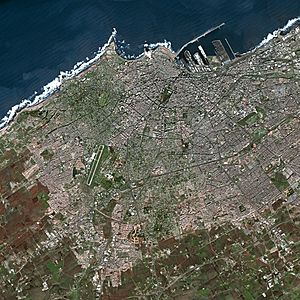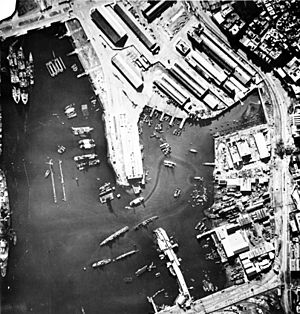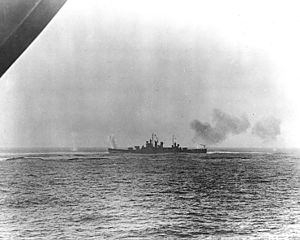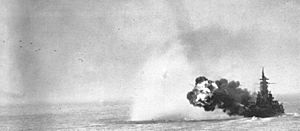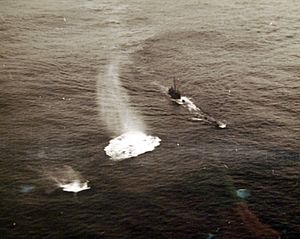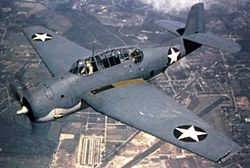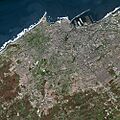Naval Battle of Casablanca facts for kids
Quick facts for kids Naval Battle of Casablanca |
|||||||
|---|---|---|---|---|---|---|---|
| Part of Operation Torch of World War II | |||||||
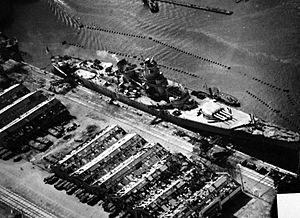 Jean Bart under attack, circa November 1942 |
|||||||
|
|||||||
| Belligerents | |||||||
| Commanders and leaders | |||||||
| Strength | |||||||
| 1 aircraft carrier 1 escort carrier 1 battleship 3 heavy cruisers 1 light cruiser 14 destroyers 15 troopships 347 landing craft 108 aircraft |
1 battleship 1 light cruiser 2 flotilla leaders 7 destroyers 8 sloops 11 minesweepers 13 submarines 7 aircraft |
||||||
| Casualties and losses | |||||||
| 174 killed 4 troopships sunk 150 landing craft sunk 5 aircraft destroyed 1 battleship damaged 1 heavy cruiser damaged 2 destroyers damaged 1 oiler damaged |
462 killed 200 wounded 1 battleship damaged 1 light cruiser destroyed 4 destroyers sunk 7 submarines sunk 1 submarine scuttled 2 submarines damaged 1 destroyer grounded 2 flotilla leaders grounded 1 submarine grounded 7 aircraft destroyed |
||||||
The Naval Battle of Casablanca was a series of sea fights during World War II. It happened between ships of the U.S. Navy and ships of Vichy France. The U.S. ships were supporting Operation Torch, which was the invasion of North Africa. The French ships were trying to defend the country of French Morocco.
The American military leaders thought that the people in Morocco would welcome them as heroes. So, 102 American ships carrying 35,000 soldiers sailed towards Morocco. They arrived secretly under the cover of darkness.
The French defenders thought the American attack was just a small distraction. They believed the main invasion would happen in Algeria. Germany saw the French giving up six Moroccan army groups to a small American force as a broken promise. This promise was to defend Morocco's neutrality under a peace agreement signed in 1940.
The last part of the battle involved German U-boats (submarines). They arrived in the area on the same day the French troops gave up.
This battle led to many surprises and a lot of mistrust. Four U.S. troopships were sunk. Also, 462 French sailors died on 24 French ships that fought against the invasion.
Contents
Background to the Battle
At the time of World War II, Morocco was controlled by France. After losing the Battle of France, the French government in Vichy signed a peace agreement with Germany. This agreement made Vichy France officially neutral. However, it also meant they had to fight anyone who tried to take French land or equipment that could be used against Germany.
General Charles de Gaulle led French forces who refused to give up. They continued fighting alongside the Allies, including the UK. The United States had recognized the Vichy government as the official one. Because of this, American military planners believed that U.S. troops would face less resistance than British soldiers during the invasion. This is why mostly American troops were used in Operation Torch.
American Forces Prepare
A large group of American ships, called convoy UGF 1, left the U.S. on October 23, 1942. More warships, including the battleship USS Ranger and several escort carriers, joined them. In total, Task Force 34 (TF 34) had 102 ships. Rear Admiral Henry Kent Hewitt led this force from his flagship, the heavy cruiser USS Augusta.
Before the invasion, American officers met with some pro-American French military officers in Algeria. The French shared information about their defenses. However, the Americans did not tell them important details about the invasion. They didn't share when, how strong, or where the forces would land. Key French leaders in North Africa were not told anything.
French Forces in Casablanca
In 1942, Casablanca was a very important port for Vichy France on the Atlantic Ocean. It was their most important naval base after Toulon. The port had strong defenses, including the El Hank coastal artillery battery with large guns.
A modern battleship, the Jean Bart, was also in port. It was not fully finished, but one of its large gun turrets was working. Other French ships in the harbor included a light cruiser, two flotilla leaders, seven destroyers, eight sloops, 11 minesweepers, and 11 submarines.
Most French officers who met with the Americans before the invasion were from the army. The French naval commander in Casablanca, Vice Admiral Michelier, was not told about the invasion. He had only recently taken his post and was not part of the secret talks.
Getting Ready for Battle
French defenders became alert when they saw invasion convoys passing through the Strait of Gibraltar. However, they didn't know where the ships were going. Task Force 34 remained hidden as it split into three groups on November 7.
One group prepared to land 9,000 troops near Port Lyautey to capture an airfield. Another group planned to land 6,500 troops near Safi to protect the southern approaches to Casablanca. The main group, carrying 19,500 troops, prepared to land near Fedala, about 15 miles (24 km) northeast of Casablanca. The landing beaches at Fedala were protected by French coastal defense batteries.
The Battle Begins
November 8: The First Attacks
American troopships anchored off Fedala at midnight. Landing craft, carrying soldiers, started moving towards the shore at 6:00 AM. French coastal batteries at Pont Blondin heard the landing craft engines. They turned on searchlights to light up the beaches. But the American support boats fired their machine guns, and the searchlights went out.
Some landing craft got lost in the dark and hit rocks. For example, 21 out of 32 landing craft from the ship Leonard Wood were destroyed. Many more were wrecked later in heavy waves.
By dawn, 3,500 American troops were ashore. However, a morning mist hid the true size of the invasion force. French shore batteries began firing on the landing craft shortly after 7:00 AM. At 7:20 AM, Admiral Hewitt allowed four American destroyers to fire back at the French guns.
The French guns damaged the destroyers USS Ludlow and Murphy. Soon after, larger American cruisers, Augusta and Brooklyn, joined the fight to protect the troopships. The American destroyers Ludlow and Wilkes silenced the Pont Blondin battery. The cruiser Augusta silenced the Fedala battery.
French fighter planes tried to stop American bombers from the carriers Ranger and Suwanee. A dogfight happened, and seven French planes were shot down, along with four or five American planes.
Bombs started falling on Casablanca Harbor at 8:04 AM. Ten civilian ships were sunk. French submarines Amphitrite, Oréade, and La Psyché were destroyed before they could leave their docks.
The American covering force, including the battleship Massachusetts and cruisers Wichita and Tuscaloosa, appeared offshore. The Massachusetts's huge 16-inch guns began firing. The El Hank battery immediately fired back, hitting near the Massachusetts.
The unfinished battleship Jean Bart also opened fire. The Massachusetts targeted the Jean Bart. After only seven shots, the Massachusetts's fifth shot jammed the Jean Bart's gun turret. The American shells caused a lot of damage, even though many didn't explode. The American ships then focused on the El Hank Battery.
While the American covering force fought the El Hank Battery, seven French ships left Casablanca harbor. They used a smoke screen to hide themselves. Their goal was to attack the American troopships off Fedala.
French destroyers Milan, Fougueux, and Boulonnais led the attack. At 9:20 AM, American fighter planes from Ranger attacked the French ships. French gunners sank an American landing craft and hit the destroyer Ludlow.
The Milan was damaged by gunfire from American ships and had to run aground to avoid sinking. The Massachusetts and Tuscaloosa then attacked the French destroyers Fougueux and Boulonnais. The Fougueux sank at 10:40 AM.
The French light cruiser Primauguet and other destroyers also left the harbor. They were outmatched by the Massachusetts and other American ships. The Primauguet was not fully ready for battle but still fired back. This French group was also attacked by Augusta and Brooklyn.
The Albatros ran aground to avoid sinking. The other French ships returned to Casablanca harbor. The Primauguet ran aground and burned, and two destroyers flipped over. Many French sailors were killed or wounded.
The French submarine Amazone fired torpedoes at the Brooklyn but missed. Another French submarine, Sibylle, disappeared. The cause of its sinking is unknown. Other French submarines, Sidi Ferruch and Le Conquérant, left the harbor without torpedoes to avoid being destroyed. Le Tonnant managed to load a few torpedoes before leaving.
The Augusta sank the Boulonnais at noon. After this, only one French destroyer, L'Alcyon, was still able to fight.
Later that afternoon, three small French warships tried to rescue sailors from the sunken destroyer Fougueux. However, American shellfire forced them to turn back. French planes bombed and attacked the landing beaches throughout the day, but they caused little damage.
By sundown, workers had repaired the Jean Bart's gun turret. The El Hank Battery was also still working. Nearly half of the 347 American landing craft had been destroyed. Fewer than 8,000 American troops had landed. Five French submarines were still a threat to the invasion fleet.
November 9: Tough Landing Conditions
At dawn, the Fedala landing beaches were hit by 6-foot (1.8 m) waves. This made it very hard to unload supplies from the troopships. Only 40% of the troops were ashore, with barely 1% of their supplies. There wasn't enough ammunition or medical supplies. Communication was also difficult because radio equipment was still on the ships. The American advance towards Casablanca stopped because they couldn't move supplies off the beach.
November 10: Jean Bart is Sunk
At 10:00 AM, French sloops Commandant Delage and La Gracieuse left the harbor. They began firing on American troops who were moving towards Casablanca. The American cruiser Augusta and destroyers Edison and Tillman chased the French ships back into the harbor. However, gunfire from the Jean Bart forced the American ships to retreat.
Nine dive bombers from the carrier Ranger attacked the Jean Bart. They hit her with two 1,000-pound (450 kg) bombs and sank her at 4:00 PM. The Jean Bart settled into the harbor mud, with her decks underwater.
French submarines Le Tonnant, Meduse, and Antiope launched torpedoes at American ships but missed. The Meduse was badly damaged by American counterattacks and ran aground off Cape Blanc.
November 11: Casablanca Surrenders
Casablanca surrendered on November 11. At this point, 11,000 tons (75%) of supplies for the American troops were still on the troopships. On this day, German submarines reached the area before the ships could finish unloading.
In the early evening, the German submarine U-173 fired torpedoes. It hit the destroyer Hambleton, the oiler Winooski, and the troopship USS Joseph Hewes (AP-50). About 100 men went down with the Joseph Hewes.
The French submarine Sidi Ferruch was sunk by Grumman TBF Avenger torpedo bombers from the carrier Suwanee on November 11.
Final Actions of the Battle
The American troopships stayed in their temporary anchorage. They needed to keep Casablanca's harbor open for more troops arriving later. However, on the evening of November 12, the German submarine U-130, led by Ernst Kals, attacked. It torpedoed the troopships Tasker H. Bliss, Hugh L. Scott, and Edward Rutledge. This attack killed 74 more American servicemen.
Because of these attacks, the undamaged troopships left the anchorage. They moved around at sea to avoid more torpedoes. On November 13, they were finally able to dock safely inside the Casablanca breakwater to finish unloading supplies.
Of the American ships hit by submarine torpedoes on November 11 and 12, all four troopships sank. However, the oiler and destroyer were repaired. The remaining troopships left Casablanca on November 17 after unloading was complete.
Some French submarines managed to escape. Amazone and Antiope reached Dakar. Orphee returned to Casablanca after the city surrendered. Le Conquerant was sunk on November 13 by two American PBY Catalina flying boats. Le Tonnant was sunk by its own crew off Cadiz on November 15. On November 16, U-173 was sunk off Casablanca by American destroyers.
During the battle, one of the Massachusetts's huge 16-inch shells, fired at the Jean-Bart, bounced off the quay. It hit a house next to the Ettedgui Synagogue in Casablanca's old city. The house collapsed, killing three people. The synagogue itself was not damaged.
Images for kids
See also
- List of French military equipment of World War II
- Attack on Mers-el-Kébir
- Atlantic Theater aircraft carrier operations during World War II#Allied Invasion of North Africa (1942)


